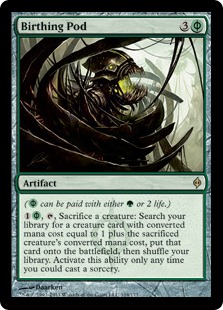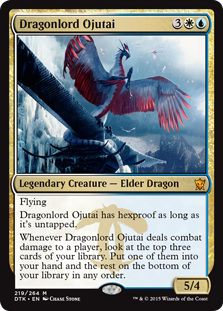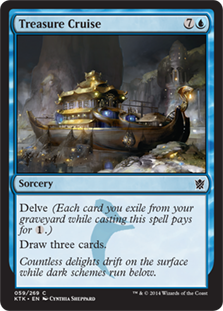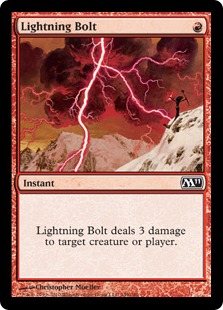Are you a Quiet Speculation member?
If not, now is a perfect time to join up! Our powerful tools, breaking-news analysis, and exclusive Discord channel will make sure you stay up to date and ahead of the curve.
So, you want to play Modern? I’ve been hearing a lot of that lately. Standard players have been flocking into the format since the start of Eldrazi Winter. A good number also flocked out when that anomaly was corrected, but quite a few have stuck around and by my observations seem a bit lost. Modern is very, very different from Standard and trying to get yourself grounded can be difficult.

It was pointed out in the comments of Sheridan’s metagame article that we don’t have a proper introduction article. While this article is not going to be the full intro that is necessary, I can at least point newcomers in the right direction. So let’s start at the beginning: What do you want to play?
All of you who just answered “a good deck” or some variant thereof, slap yourself.
This is important, maybe the most important question when it comes to Modern. What deck do you want to play? Any deck can be viable. Abzan Company, Jund, Infect, Grixis, and Burn may consistently sit near the top of our metagame standings but they’re hardly the absolute best decks. In fact there really isn’t a true “Best Deck” in Modern. With Eldrazi (finally) banned there isn’t a deck that has a clear advantage in every matchup. Modern decks are either high-variance combo decks (Infect, Grishoalbrand), have some very good matchups and some nearly unwinnable matchups (Burn, GR Tron) or have across-the-board average matchups (GBx). You can’t just “play a good deck” or “play the best deck”---there’s more to Modern than that.
[wp_ad_camp_1]
What is Modern?
Sheridan has been working hard to define Modern, and Wizards is finally helping him out. However, those explanations are a little technical for my taste for introducing players to Modern. For simplicity’s sake, I tell them that Modern is a huge format with a massive cardpool and completely open metagame. Think about it, we have the past thirteen years of Magic in the format and for the first time there isn’t a truly format-defining, interact-with-me-or-lose deck. Splinter Twin’s gone, Birthing Pod’s gone, Treasure Cruise’s gone, and Jund is depowered enough to not be the default configuration of GBx.
However, those explanations are a little technical for my taste for introducing players to Modern. For simplicity’s sake, I tell them that Modern is a huge format with a massive cardpool and completely open metagame. Think about it, we have the past thirteen years of Magic in the format and for the first time there isn’t a truly format-defining, interact-with-me-or-lose deck. Splinter Twin’s gone, Birthing Pod’s gone, Treasure Cruise’s gone, and Jund is depowered enough to not be the default configuration of GBx.
The cardpool is massive but it lacks the overwhelming power and consistency of Legacy or Vintage. This is the most exciting and frustrating aspect of Modern. The key to success is not necessarily your choice of deck but how well you understand and pilot your deck in the metagame. Sure, the popular decks are popular for a reason but that does not mean they are the optimal choice, especially for beginners. Far more than in Standard you have to take ownership of your deck and put in the time to learn how to play the matchups, how to sideboard and the optimal numbers for your maindeck.
The Importance of Deck Choice
The hardest thing I’ve found for new Modern players is how different it is from Standard. In Standard card power can sometimes make up for inexperience or suboptimal play, but Modern is more about card synergy and tempo and for this reason you cannot rely on the power of your deck to pull you though. It will happen some of the time, but more experienced players will recognize inexperience and misplays, and will know exactly how to punish you. Experience and format knowledge will get you a far greater edge than trying to metagame your deck choice.
I’ve heard Standard described as an amorphous blob where there are a number of good cards and that the greatest skill is to know when and how to combine these cards for a given tournament. It’s more about deck choice and positioning than skill with any one deck.
It’s more about deck choice and positioning than skill with any one deck.
Modern is different. It's not so much about piles of powerful cards as it is internal synergy and incremental advantage. Yes, Jund looks like a pile of good cards, and it is, but it wouldn't be Modern Jund if the pieces didn't work together well and there wasn't a lot of synergy between the cards that gradually pull you ahead. Haymakers are rare (outside of Tron) and hard to resolve so it's far more about efficiency and combinations of cards than Standard. There are decks that don’t play “normal” Magic like Lantern. Many decks may attack from the same angle(s) but they operate and must be answered in very different ways; think Zoo vs. Affinity. Your deck may change its matchup role based on who wins the die roll and which game you’re on.
Therefore the experience necessary to pilot a Modern deck optimally is much higher than Standard and this means that more practice is necessary. Picking up a netdeck is a good place to start, but you cannot leave it there.
This is especially important since there are no consensus best builds in Modern. Many cards will be common between builds but they won't always be in the same proportions. In Standard there tend to be correct builds, like the Blue Devotion and Azorius Control decks from Theros/Return to Ravnica Standard. Decklists tend to merge together in Standard thanks to the smaller cardpool, but in Modern there is tremendous variation within archetypes except for a few combo decks. These card choices also tend to have an enormous effect on the deck's positioning and role, to the extreme that you can make your deck exactly fit your preferences and play style.
Decklists tend to merge together in Standard thanks to the smaller cardpool, but in Modern there is tremendous variation within archetypes except for a few combo decks. These card choices also tend to have an enormous effect on the deck's positioning and role, to the extreme that you can make your deck exactly fit your preferences and play style.
All Modern Junk lists will have Inquisition of Kozilek, Thoughtseize, Liliana of the Veil, Tarmogoyf, and Lingering Souls but the numbers of each card vary deck to deck depending on how the pilot sees the format and the speed they want for the deck. Slower decks will play more discard while a faster deck will cut some discard for Birds of Paradise. Tempo-oriented RUG Scapeshift decks will play Remand where the control versions pack Mana Leak, but a more combo-focused deck may have Spell Pierce and Dispel instead. Deck tuning and optimization are a huge part of Modern and are a critical skill to develop, and to do that you will need to put in a lot of practice.
Getting Started
If this sounds intimidating, then well done, you were paying attention. But don’t let that put you off. There is a very good reason to play Modern despite the intimidation. I mentioned it in the first paragraph. What do you want to play? Modern is a format where you can play any deck and win. I am completely serious. Remember when I said that the field was now completely open? It is also largely unexplored. There is no reason to stick to the mainstream decks if you don’t want to. Put the time in, and your odd combo deck might become the next Lantern Control breakout (though it’d be nice if it were also more fun to play against). So, start practicing and optimizing.
I am completely serious. Remember when I said that the field was now completely open? It is also largely unexplored. There is no reason to stick to the mainstream decks if you don’t want to. Put the time in, and your odd combo deck might become the next Lantern Control breakout (though it’d be nice if it were also more fun to play against). So, start practicing and optimizing.
Another reason to play your own deck is you need to play your deck a lot to be successful in Modern. This means it is important to play what you most enjoy playing. When playing or even goldfishing a deck is fun, testing isn’t a chore. To really get the most out of your deck you need to master it so why force yourself to play something just because you think it’s good? Rogue pet decks can win just as easily as the known decks. In fact, examining even stock decklists shows considerable variation between archetypes that reflects the testing and preferences of their pilots. So there is no reason not to play your deck.
Why is This?
Consider Pro Tour Fate Reforged. The most-played decks were Junk, Infect, Twin and Burn.  Why? The short answer is that the two decks that were most played prior to that tournament, Birthing Pod and UR Treasure Cruise Delver, were banned and this left most of the Pros adrift. This left them to fall back on previous decks or look for decks to which they could transfer their established skills. Junk and Pod had a fair amount of overlap as did Twin and Delver so it makes sense that Junk and Twin were very popular. When you don’t play much Modern or are uncertain about a new brew this makes a lot of sense.
Why? The short answer is that the two decks that were most played prior to that tournament, Birthing Pod and UR Treasure Cruise Delver, were banned and this left most of the Pros adrift. This left them to fall back on previous decks or look for decks to which they could transfer their established skills. Junk and Pod had a fair amount of overlap as did Twin and Delver so it makes sense that Junk and Twin were very popular. When you don’t play much Modern or are uncertain about a new brew this makes a lot of sense.
Burn is always a reasonable deck given how much damage decks do to themselves, and it got much better once Pod left and there were fewer Kitchen Finks running around, making it an attractive metagame choice. It also benefited from the perception that it’s a zero-skill autopilot deck (it very much is not) which bumped its numbers up.
Infect was the only surprise among the top four decks. Its numbers weren't explainable by positioning or familiarity but because The Pantheon team by and large adopted the deck on Tom Ross’ insistence. Infect has always been around but since the first wave of bannings hasn't been very good. The results of GP Vancouver before the Pro Tour indicated that it was better than before thanks to Become Immense, and was probably well-positioned for the GP. However, the only member of Pantheon running Infect to place highly was Jon Finkel, because Jon Finkel. By several accounts after the tournament he would have rather played Storm like he usually did, since it had better matchups against the decks he actually faced than Infect, which really struggles against Lingering Souls and Lightning Bolt.
More surprising and instructive was Justin Cohen getting second with Amulet Bloom. Bloom had been around for some time but was always seen as a bad fringe combo and never seriously considered. However according to the coverage Justin disagreed and had put in the time to master the deck, which proves the value of investing time in Modern. He actually understood how to play the deck against the unprepared field and correctly read the metagame as favorable for his glass cannon deck (if you were unaware, Bloom just loses to Blood Moon). He knew what he was doing and could navigate his deck around everything that his opponents threw at him until the finals. His preparation and experience were rewarded and should be your model to Modern success.
The Problem of Modern
One final note for newbies: you need to accept that you will have poor to unwinnable matchups. Certain decks will have natural advantages over others that cannot be fixed with any amount of sideboarding, such as the aforementioned Blood Moon against Bloom. Other decks are simply very well-positioned against other decks, like Infect against Soul Sisters and Tron. Infect can lose those matchups, but it isn’t likely (Infect ignores most of Sisters’ deck and is too fast for non-interactive Tron). This is balanced by these same decks having very good matchups against other decks, like Tron against GBx decks or Sisters crushing Burn.
Certain decks will have natural advantages over others that cannot be fixed with any amount of sideboarding, such as the aforementioned Blood Moon against Bloom. Other decks are simply very well-positioned against other decks, like Infect against Soul Sisters and Tron. Infect can lose those matchups, but it isn’t likely (Infect ignores most of Sisters’ deck and is too fast for non-interactive Tron). This is balanced by these same decks having very good matchups against other decks, like Tron against GBx decks or Sisters crushing Burn.
This is the natural result of the diversity of the metagame and the cardpool size---you have to just accept it and move on. The only alternative is to have average matchups across the board, never being particularly favored or disadvantaged and having to grind out wins most games, which is what Junk and Jeskai Control do. You just need to pick your poison and try to compensate as best you can.
Find Your Deck
So now that you know what you’re in for, it’s time to actually pick a deck. The best way to approach a new format is from the one you know, so the natural place to start is with a port of a Standard deck. However I would recommend against a straight port of your favorite Standard deck especially if it was a reactive deck. Until you know the format well, trying to build your own deck can be an exercise in frustration, particularly if you want to play control.
 I’m not going to lie, there is going to be some sticker shock, though the recent Standards may lessen the impact (the price for Jace is just ridiculous). There are a lot of older cards that are scarce for many reasons and as a result are very pricey (If you’re looking to pick up Jund your accountant may have a heart attack). This is balanced by the fact that once the initial investment is made there is very little additional overhead to Modern. Most of the truly staple cards like the manabase and utility spells are safe from bannings and see play in lots of different archetypes so even if you tire of one deck you’ll have little trouble or expense building another. It might be daunting to get in, but stick around for a few years and it will pay off. Ultimately Modern is cheaper than Standard over the long term.
I’m not going to lie, there is going to be some sticker shock, though the recent Standards may lessen the impact (the price for Jace is just ridiculous). There are a lot of older cards that are scarce for many reasons and as a result are very pricey (If you’re looking to pick up Jund your accountant may have a heart attack). This is balanced by the fact that once the initial investment is made there is very little additional overhead to Modern. Most of the truly staple cards like the manabase and utility spells are safe from bannings and see play in lots of different archetypes so even if you tire of one deck you’ll have little trouble or expense building another. It might be daunting to get in, but stick around for a few years and it will pay off. Ultimately Modern is cheaper than Standard over the long term.
 For this reason, now is an excellent time for Standard players to get into Modern! Wizards has printed a number of unexpectedly good cards over the past couple years that you’ve probably played in Standard which are also seeing considerable Modern play. Collected Company, Jace, Vryn's Prodigy, Atarka's Command, and Tasigur, the Golden Fang all see heavy Modern play and the fetchlands are essential. Take a look around: you may already have most of a deck and just need to fill out some older staples.
For this reason, now is an excellent time for Standard players to get into Modern! Wizards has printed a number of unexpectedly good cards over the past couple years that you’ve probably played in Standard which are also seeing considerable Modern play. Collected Company, Jace, Vryn's Prodigy, Atarka's Command, and Tasigur, the Golden Fang all see heavy Modern play and the fetchlands are essential. Take a look around: you may already have most of a deck and just need to fill out some older staples.
I can’t give you advice about what deck to actually play because I don’t know what your Standard deck is, nor do I know what you want to play. What I can do is point you to a number of example decks that are similar to current or recent Standard decks to use as guides.
Abzan Company is very popular, largely based on how well it did during Eldrazi Winter, and while its creature base is fairly old and expensive most of the support spells and mana have been reprinted enough that you can get them reasonably cheap. Grixis in its many forms also plays quite similarly in Standard and Modern if you want to go the control route, but be warned that the deck actually functions differently most of the time (closer to midrange aggro-control than true control). Eldrazi may have been depowered but is still a threat, and there are plenty of different builds you can pick up fairly inexpensively. All that’s left is to find your deck and start testing!
This is just an introduction. Once you learn what is being played you can tune the maindeck and sideboard for your metagame and eventually start to branch out to make your own deck and really start to enjoy Modern. So, do you want to play Modern?





Um, your next-to-last paragraph ends mid-sentence. Otherwise, though, nice article.
Looks like copy-paste got the better of me. Fixed.
This is a fun way to figure out what you want to play in modern. (a little, ok a lot outdated) https://i.warosu.org/data/tg/img/0307/58/1394478137874.jpg
Interestingly, I was planning on including an updated version of that very chart in this article, but it wasn’t ready in time. Stay tuned :).
Great article. Clear and well written. Moreover just yesterday I was thinking half the things you wrote. Keep it up. I’m waiting for the chart you mention. I think it’s pretty fun.
The one thing I think people should keep in mind is the quality of top decks in modern. There are a ton of combo decks and you can control them well only to have them draw scapeshift, Ad Naus, become immense, etc.
Ability to close a game is a very real consideration in modern. It’s one of the reason why Jund tends to win even as a tap out control type deck, its creatures create a very fast clock that demands a lot out of the combo deck. Whereas as decks like grixis or blue moon tend to durdle around after they get control and that leads to lots of feel bad moments where you lose a game you had under control.